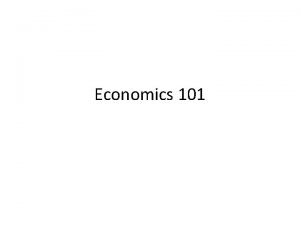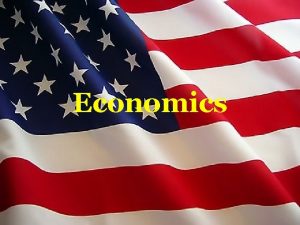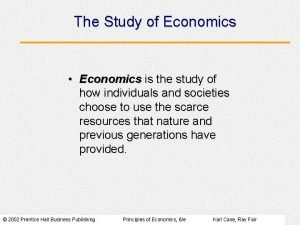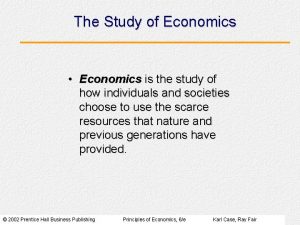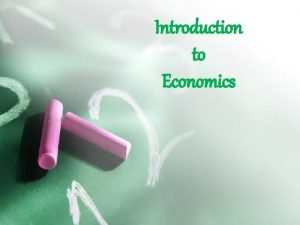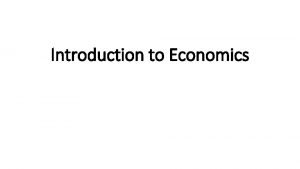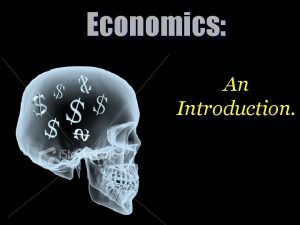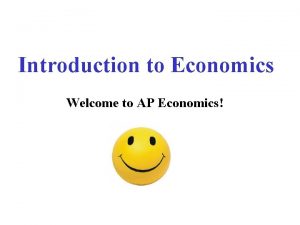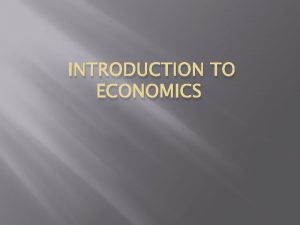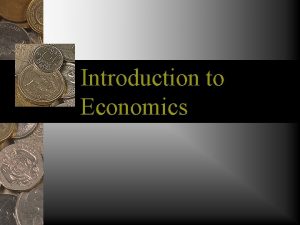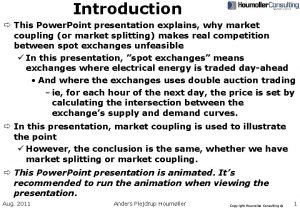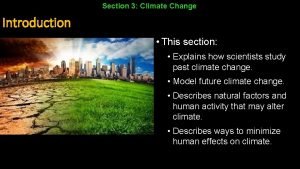Introduction to Economics The study of economics explains

















- Slides: 17

Introduction to Economics

� The study of economics explains how productive resources are used to provide the goods and services that satisfy human wants and needs. � Scarcity is the fundamental economic problem facing all societies. We have limited resources and unlimited needs and wants.

Scarce Resources � Human � Natural � Capital

Needs v. Wants � Needs: Food Shelter Clothing

Goods v. Services

Factors of Production: � Land (natural resources) � Labor (human resources) � Capital (equipment, machinery) � Entrepreneurship

Basic economic questions: � What goods and services will be produced? � How will goods and services be produced? � Who will consume the goods and services? (How should it be shared? )

The study of economics… � Economics is considered a social science. Why? � What do economists do? is the difference between microeconomics and macroeconomics?

Microeconomics and Macroeconomics • • LO 3 Microeconomics • Decision making by individual units Macroeconomics • Examines either the economy as a whole or its basic subdivisions or aggregates 1 -9

Positive and Normative Economics • Positive economics • • Normative economics • LO 3 Deals with economic facts A subjective perspective of the economy 1 -10

Theories, Principles, and Models • The scientific method Observe Formulate a hypothesis Test the hypothesis Accept, reject, or modify the hypothesis Continue to test the hypothesis, if necessary • LO 2 Economic principles • Generalizations • Other-things-equal assumption • Graphical expression 1 -11

Factors influencing economic development… � Technology � Specialization � Division of Labor

Other important concepts: � Trade-off � Opportunity Cost � Production Possibilities Curve (PPC)

Production Possibilities Model Production Alternatives Type of Product Pizzas A B C D E 0 1 2 3 4 10 9 7 4 0 (in hundred thousands) Industrial Robots (in thousands) Plot the Points to Create the Graph… LO 5 1 -14

Industrial Robots Production Possibilities Model 14 13 12 11 10 9 8 7 6 5 4 3 2 1 A B C U Unattainable D The law of increasing opportunity costs makes the PPC concave. Attainable E 0 1 2 3 4 5 6 7 8 9 Pizzas LO 5 1 -15

Industrial Robots A Growing Economy 14 13 12 11 10 9 8 7 6 5 4 3 2 1 A’ B’ Unattainable A B C’ C Economic Growth D’ D Now Attainable E’ E 0 1 2 3 4 5 6 7 8 9 Pizzas LO 6 1 -16

Present Choices, Future Possibilities LO 6 Future Curve Current Curve P Goods for the Future Compare Two Hypothetical Economies F Future Curve Current Curve Goods for the Presentville Futureville 1 -17
 Hát kết hợp bộ gõ cơ thể
Hát kết hợp bộ gõ cơ thể Bổ thể
Bổ thể Tỉ lệ cơ thể trẻ em
Tỉ lệ cơ thể trẻ em Chó sói
Chó sói Chụp phim tư thế worms-breton
Chụp phim tư thế worms-breton Hát lên người ơi alleluia
Hát lên người ơi alleluia Môn thể thao bắt đầu bằng từ đua
Môn thể thao bắt đầu bằng từ đua Thế nào là hệ số cao nhất
Thế nào là hệ số cao nhất Các châu lục và đại dương trên thế giới
Các châu lục và đại dương trên thế giới Công thức tiính động năng
Công thức tiính động năng Trời xanh đây là của chúng ta thể thơ
Trời xanh đây là của chúng ta thể thơ Mật thư anh em như thể tay chân
Mật thư anh em như thể tay chân 101012 bằng
101012 bằng Phản ứng thế ankan
Phản ứng thế ankan Các châu lục và đại dương trên thế giới
Các châu lục và đại dương trên thế giới Thơ thất ngôn tứ tuyệt đường luật
Thơ thất ngôn tứ tuyệt đường luật Quá trình desamine hóa có thể tạo ra
Quá trình desamine hóa có thể tạo ra



















